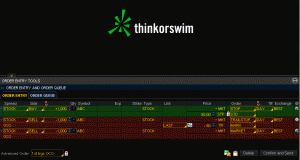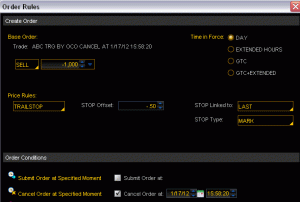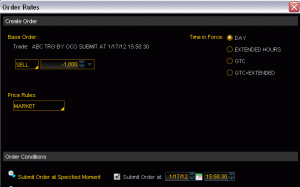Search Results for 'traders'
Why Anticipatory Trading is so Tricky
Charts give us the opportunity to wait for confirmation or enter ahead of time – to anticipate. And while the latter may give us more of a feeling of being right, it’s not an easy way to trade.
Here’s an example from this week…
AGP is sitting in a bullish consolidation pattern here within an existing uptrend. This is a quality pattern – but it has yet to confirm. A breakout would happen beyond the upper channel trend line, currently at $70. Check out the setup, then down below let’s discuss trading it.
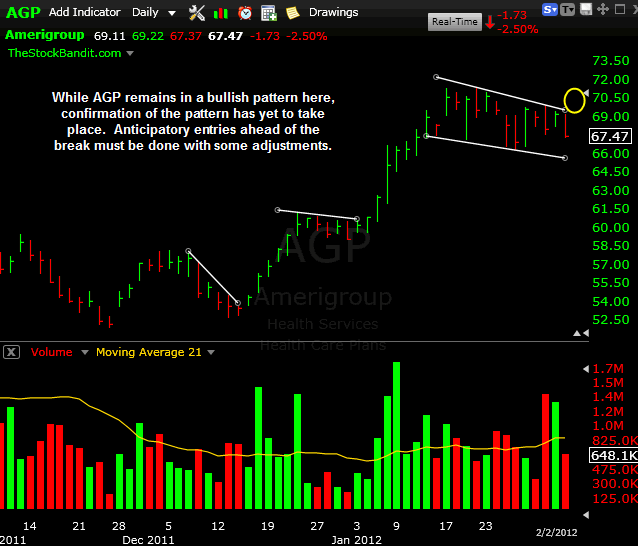
This is a setup which would have delivered some frustration for those anticipating a breakout – at least for those who entered early. Wednesday saw a move back up toward the upper channel line, suggesting a breakout was perhaps coming soon, only to have a decisive turn lower on Thursday bring it right back into the center of the channel. The stock is again lower this morning.
There’s a huge difference between how pro’s and amateurs make anticipatory trades, let’s see what they are and what those choices lead to.
How Amateur Traders Anticipate
Many amateur traders make anticipatory trades. They receive a tip, or they have a hunch, or they just want to see their predictions proven, and they get in before any bit of a move has started. They load up, then wait to get paid. A failure of the stock to deliver the move results in the max loss possible under this circumstance, all because of how the amateur entered the trade.
How Professional Traders Anticipate
Many professional traders make anticipatory trades as well. Their experience provides them with market feel, and when watching the tape and eyeing the charts, they’ll run across trades they like too – maybe even the exact same setups as the amateur finds. However, their execution methods are worlds apart.
Rather than piling into the trade and sitting back and hoping the market proves them correct, the professional enters a feeler position – a starter. A trade small enough to watch but not big enough to hurt them or really help them. It’s a marker. As the trade begins to prove itself and the pattern starts to confirm, they add to the trade. They build a position as it works, allowing them to get paid nicely when their hunch proves correct. A failure of the stock to deliver the expected move results initially simply leaves them stopping out of their starter position for the bare minimum loss.
See the difference between the two?
There’s a big argument to be made for just waiting for confirmation in a pattern to take place before entering a trade, but anticipatory trading can still produce profits, so long as you’re doing it carefully.
For those of you anticipatory traders, the example above is a great example of how to finesse your entry. Scale in, make the setup confirm before adding, and know you’re covered either way – whether a tiny loss you can easily survive or a winning trade you can build on.
(For more on anticipatory trading, read When to Make Anticipatory Trades.)
Trade Like a Bandit!
Jeff White
Producer of The Bandit Broadcast
Follow TheStockBandit on Twitter or get our free newsletter to keep up!
Competition
One of the many harsh realities of trading is that it takes a lot of intentional effort.
That means you intentionally prepare (both mentally and with an actual game plan), you intentionally execute (have the discipline to stick with your method), and you intentionally improve (by reviewing results, keeping an open mind, working with other traders to expand your abilities, etc.).
 The fact of the matter is that if your competition is outgunning you, the way to start having more success is by outworking them.
The fact of the matter is that if your competition is outgunning you, the way to start having more success is by outworking them.
When I was in 8th grade, I decided to take up golf. Being in a town with a huge presence of great players (including 8 PGA Tour pro’s), I had an uphill battle given that so many of my peers had already been pursuing the game for a few years. They were better than me, and I knew I had to outwork them in order to catch up to them or surpass them.
The same mindset applies to your trading. If your competition is getting the best of you, then you’ve gotta step up your game and work harder. Don’t be afraid of it, nothing worth doing is ever easy.
Trade Like a Bandit!
Jeff White
Producer of The Bandit Broadcast
Follow TheStockBandit on Twitter or get our free newsletter to keep up!
Video Review of the Indexes 1-29-2012
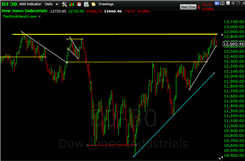 Last week the senior indexes put in some much-needed rest with the news flow prompting a bit of a pause in the action. Big-name earnings reports, the State of the Union address, and an FOMC meeting all left traders unwilling to press the upside for the most part, allowing the market the opportunity for some healthy basing.
Last week the senior indexes put in some much-needed rest with the news flow prompting a bit of a pause in the action. Big-name earnings reports, the State of the Union address, and an FOMC meeting all left traders unwilling to press the upside for the most part, allowing the market the opportunity for some healthy basing.
In preparation for the trading week ahead, let’s examine some important levels to keep an eye on for the indexes. That will have the greatest influence on how individual stocks are going to move, so it’s part of our Sunday process.
(Direct video link is here for those interested in embedding it elsewhere to share).
Be sure to view in HD (720P) and full-screen mode for best quality in the video.
Trade Like a Bandit!
Jeff White
Producer of The Bandit Broadcast
Get our free newsletter to keep up!
Follow @TheStockBandit
The Zurich Axioms
 I first learned about The Zurich Axioms by Max Gunther in the daily Worden Report when Don mentioned it among his favorite trading books a few years ago. Soon after, I picked up a copy and found it was indeed packed with some great insights – enough to be a must-have trading book.
I first learned about The Zurich Axioms by Max Gunther in the daily Worden Report when Don mentioned it among his favorite trading books a few years ago. Soon after, I picked up a copy and found it was indeed packed with some great insights – enough to be a must-have trading book.
There are 12 major axioms highlighted in the book, with a chapter devoted to each, as well as 16 minor axioms. It’s a relatively short book at only about 123 pages, but the “Rules of Risk and Reward Used by Generations of Swiss Bankers” offers no shortage of wisdom and insights for any trader or speculator.
Without disclosing all of the Axioms, I’ll summarize two of my favorites.
Always Play for Meaningful Stakes.
This minor axiom highlights the importance of trading with enough size for it to matter. This goes beyond the learning stages in which a developing trader needs to hone his skills and not fixate on the money. Rather, playing for meaningful stakes is about getting over the fear of getting hurt in such a way that when a play works, it’s well worth the risk taken.
A story is told in the book about the oil tycoon J. Paul Getty, who grew up rich, but once he became an adult he was sent out on his own. Wanting to enter the oil business, he shunned various opportunities to invest $50 in the early 1900’s in favor of betting nearly his entire savings of $500 on an oil lease he felt was more promising. After paydirt was hit, he sold his holdings for $12,000 just a short time later.
Getty mentioned that if he had not struck oil, the $500 would have hurt, but that he could have found a way to save that amount back up again. He was quoted as saying “it seemed to me I had a lot more to win than to lose.” That’s playing for meaningful stakes.
As a trader, it’s not about walking a tightrope where bankruptcy is the result if you slip. It means you don’t nickel-and-dime your way throughout the entire year if you want to get somewhere interesting.
Optimism means expecting the best, but confidence means knowing how you will handle the worst. Never make a move if you are merely optimistic.
What an excellent reminder for traders! Gunther makes the point that without some level of optimism, one cannot trade to begin with. However, there is general optimism and there is specific optimism. According to Gunther, it’s the venture-specific optimism which can become dangerous if you allow it.
The latter mention of what true confidence is just cannot be ignored here. Do you know how you will handle the worst? If you do, then you’ve got arguably the most difficult element of a trading plan already in place – the adverse exit. The ability to fail gracefully in trading – over and over – is what will ultimately define how long you can stay in the game. Your success may eventually be tremendous, but if you’re unable to handle losing the right way, you’ll be taken out long before the big wins can ever come along.
My advice? Pick up a copy of The Zurich Axioms and get a pen ready to mark up the margins and underline key points. It’s a quick read and one you’ll return to often.
Trade Like a Bandit!
Jeff White
Producer of The Bandit Broadcast
Follow TheStockBandit on Twitter or get our free newsletter to keep up!
Walk Away from Your Day Trades
Intraday plays can offer exceptional opportunities for not only capturing quick moves, but also for managing risk by avoiding the overnight gap risk. It’s a timeframe which full-time traders often participate in, but one which the part-time trader often avoids due to a perceived inability to manage the trade effectively.
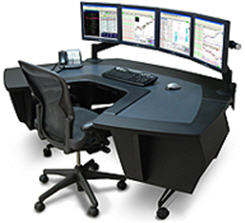 With today’s trading technologies available to us all, there’s no longer an excuse for missing out on moves when away from your screens. The bracket order is a well-known device for the set-it-and-forget-it type of trade, but there are aspects of it which few utilize.
With today’s trading technologies available to us all, there’s no longer an excuse for missing out on moves when away from your screens. The bracket order is a well-known device for the set-it-and-forget-it type of trade, but there are aspects of it which few utilize.
I’ve realized through helping so many part-time traders who desire to capture some intraday moves that it’s common to simply think inside the box. Most of them view a bracket order as an entry, a stop, and a limit order (set at the target). That’s not at all a bad way to do it, and in fact it’s exactly how I use brackets on my swing trades.
Get Creative
For day trades and the bracket order, a little creativity can go a long way. Mix up the parameters from the usual bracket order you use and throw in a couple of different variables.
One of your stop choices is the trailing stop, which can be excellent for intraday trading. This order allows you to designate either a percentage or a price amount which the stock would have to retreat from its best level (since the trade was entered) in order to trigger a closing order. For the trader seeking to grab as much of an intraday trend as possible, this is a great option to have available – particularly in momentum names which have the ability to keep running.
Another choice which can be made is the time stop for managing exits. This order is based on the clock, so once a given time of day is reached, the next action can be triggered (sell!). Since the whole idea of a day trade is to capture intraday movement and not hold overnight, consider setting a time-triggered order to exit the position ahead of the closing bell.
Here’s what the basic order structure would look like on the thinkorswim platform with a stop buy entry if ABC clears $50, with a trailing stop of $0.50 and a time stop for a market sell late in the day (click to enlarge image):
The trailing stop is set to cancel 10 seconds before the time stop, just for the safety of not having the orders overlap (even though there should be no issue). I clicked the little gear icon beside the order on the far right side of the image above, then selected ‘Cancel order at Specified Moment’ and designated an exact time to cancel the trailing stop (click to enlarge):
The time stop is simply a market sell order which will go live at the designated time, in this case 90 seconds before the closing bell. Again, clicking the gear icon brings up this dialogue box where I simply checked ‘Submit Order at Specified Moment’ and set the time (click image to enlarge):
The bottom-line lesson is this: even as a part-time trader, you can still participate in some intraday moves. Use the technology which is at your disposal, and think outside the box a bit. It can help you manage risk effectively, and if the trade works you can lock in some solid profits – without sitting at your desk!
Trade Like a Bandit!
Jeff White
Producer of The Bandit Broadcast
Follow TheStockBandit on Twitter or get our free newsletter to keep up!
Setting Stops: Fixed or Variable?
 Dmitriy recently asked:
Dmitriy recently asked:
“Do you think that fixed stop-loss is better than a stop-loss which is based on market setup (stop below the low of the pullback or below support level)? If for instance, you trade ES or some stock every day, is it best to use a fixed stop-loss, say 3 points in any trade, or one which is based on the unique price pattern and hence requires a different size stop-loss every time (one trade may require 4 points, another 5 points)?”
This is a great question and one I’m glad he asked. Traders of many markets and of differing timeframes wonder about this and come up with mixed signals.
On the one hand, maybe they’ve read O’Neil say in How to Make Money in Stocks to limit one’s loss to 7-8%, which is a fixed amount that doesn’t vary from one trade to another. On the other hand, they realize that no two stocks are exactly alike (or futures or options or whatever instrument is in question). That kind of thinking would necessitate different sized stops depending upon what’s being traded.
 My personal preference is to go with the latter line of thinking. I base my stops on current conditions and the pattern being traded. Some markets are faster than others, so they warrant a smaller position but wider stop. Others are slower and more steady, so they can be traded with larger size but a tighter stop. Personalities of stocks can greatly vary, so it’s difficult to apply a one-size-fits-all stop to every trade you make.
My personal preference is to go with the latter line of thinking. I base my stops on current conditions and the pattern being traded. Some markets are faster than others, so they warrant a smaller position but wider stop. Others are slower and more steady, so they can be traded with larger size but a tighter stop. Personalities of stocks can greatly vary, so it’s difficult to apply a one-size-fits-all stop to every trade you make.
The bottom line is this: those who commit to learning the technicals by studying price action, learning patterns, and personalities of stocks can utilize custom-fit stops and gain a ton of flexibility. By contrast, those who lack that commitment are stuck with using a set percentage which will be more than enough in some cases and not enough in others – very hit and miss.
Grow, learn, and improve – it’s the best investment you could possibly make in your trading.
Trade Like a Bandit!
Jeff White
Producer of The Bandit Broadcast
Follow TheStockBandit on Twitter or get our free newsletter to keep up!
3 Ways to Grow from Trading Adversity
Dean Karnazes runs like a man possessed. He’s an ultramarathoner, which means he goes beyond marathon distances – sometimes a lot farther. He once ran 50 marathons in 50 states in 50 consecutive days. Apparently, the dude loves pain.
In his book Confessions of an All-Night Runner, he makes the following statement:
“Struggling and suffering are the essence of a life worth living. If you’re not pushing yourself beyond the comfort zone, if you’re not demanding more from yourself – expanding and learning as you go – you’re choosing a numb existence. You’re denying yourself an extraordinary trip.”
So, this being a trading blog, it begs the question: how well do you embrace the struggle of trading? At times it’s really smooth, and trading can provide extraordinary profits in incredibly brief amounts of time, but not always. Sometimes trading’s a real grind. You question everything you’re doing, your results offer you no condolences, and you’re just flat-out suffering.
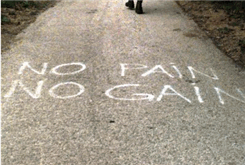 If you’ve been through that before and you’re still a trader, congratulations! You have been able to overcome the pain and doubt and press on and work your way out of it. Others of you, however, might be facing that right now for the first time and you’re wondering if you have what it takes.
If you’ve been through that before and you’re still a trader, congratulations! You have been able to overcome the pain and doubt and press on and work your way out of it. Others of you, however, might be facing that right now for the first time and you’re wondering if you have what it takes.
Here’s the thing…if you fall into the latter camp, this is where the rubber meets the road. You’re facing a choice of whether to persevere or to walk away. While moving forward might or might not deliver the success you so badly want, I can guarantee you that permanently walking away will never allow you to reach your trading goals.
Struggle, Suffering, and Success
Struggling and suffering in trading are common side effects of the job, they come with the territory. As you well know, if it were easy then everyone would be doing it. Trading can be hard, it can be demanding, and boy can it be frustrating.
That same struggle can also propel you to new heights of success, but you have to respond the right way – and it’s not gonna be comfortable.
3 Ways to Grow from Trading Adversity:
1. Appreciate the ache. It doesn’t mean you enjoy the frustration. Appreciating it means you acknowledge it’s here, you recognize the fact that a change is needed, and you understand that if you don’t shift in some way it’ll be the end of your trading – at least for a while.
2. Expect to grow. Why shouldn’t you? What you’re doing isn’t working, as otherwise you wouldn’t be facing adversity to begin with. Watch for new kinds of moves, implement some different techniques, and anticipate some different results. If you survive, you’re going to be a better trader because of this time and how you respond to it.
3. Require more from yourself. Maybe you got stagnant, and that’s what brought you to this point of frustration. You’ve had some approaches which have worked, and you rested on them – perhaps a little too much. As traders, we have to continually blend a loyalty to what’s working now with a willingness to employ some new methods. So push yourself more going forward, keep moving, never sit idle when it comes to growing as a trader.
And finally, for some of you this is a wake-up call. You’re starting to become set in your ways, but you now recognize you’re in for a rude surprise if you continue to operate in that manner. No more! Seek out ways to improve, to grow, to add to your skill set. Because according to Dean, getting stuck in your comfort zone means you’re denying yourself something extraordinary – maybe even that elusive next level.
Trade Like a Bandit!
Jeff White
Producer of The Bandit Broadcast
Follow TheStockBandit on Twitter or get our free newsletter to keep up!


